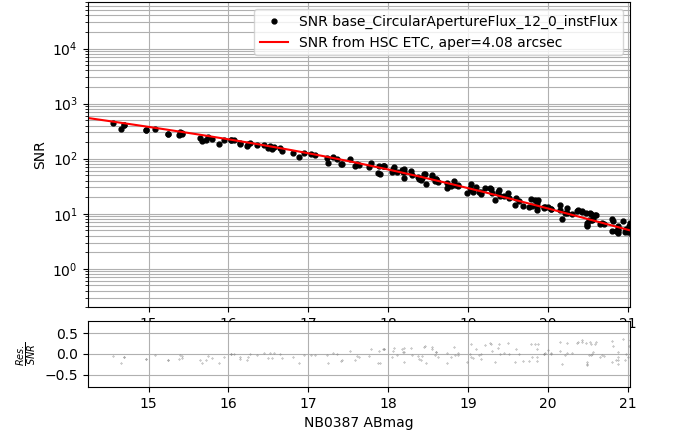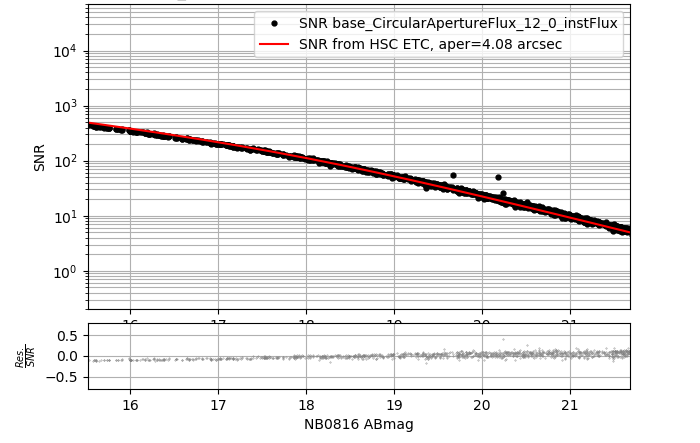|
The HSC Exposure Time Calculator (ETC)
has recently been updated to improve the accuracy of signal-to-noise ratio (SNR) estimation.
This report describes our evaluation of the latest HSC ETC as of July 2021 (version 2.2) using HSC observation
data obtained mostly in early 2018 which is shortly after the primary mirror recoating (see the Transparency
plot here).
The data were reduced with the HSC pipeline
(hscPipe) version 7 and the measured fluxes of detected point-sources were obtained from the
resulting SRC catalogs.
For each point-source in a set of 16 CCDs near the center of the field-of-view, the SNR within a circular
aperture was calculated using the expression

where F∗ is the flux in ADU from the 12 pixel circular aperture
(derived from “base_CircularApertureFlux_12_0_instFlux” in the SRC catalog),
Npix is the number of pixels within the aperture, and σsky is
the standard deviation of the local sky level (derived from
“base_LocalBackground_instFluxErr” in the SRC catalog).
Each source's magnitude was calculated using the hscPipe routines
getPhotoCalib for photometric calibration and
instFluxToMag to transform the flux into AB magnitude.
The figures below show the comparisons of SNR measured with the above equation against SNR estimates
from the ETC for the corresponding observing conditions (i.e., seeing, transparency, and moon phase/distance)
within a circular aperture of a 4.08 arcsec diameter (= 12 pixels in radius).
The horizontal axis range is determined to be between the saturation and limiting magnitude values reported
by the ETC.
Although the ETC might underestimate or overestimate the SNR slightly due to the specific observing condition
such as the sky level,
overall the figures show that the ETC is able to accurately estimate the SNR within a few percent for the entire
dynamic range of the detector, which suggests that the systematics and
noise sources have been properly modeled in the ETC algorithm.
Broad-band filters
- HSC-g data in January 2018: exptime = 150 sec, seeing = 0.86″, transp = 1.00, sky level = 4.0 ADU/sec

- HSC-r2 data in January 2018: exptime = 300 sec, seeing = 0.77″, transp = 1.00, sky level = 10.2 ADU/sec

- HSC-i2 data in January 2018: exptime = 30 sec, seeing = 0.61″, transp = 1.00, sky level = 19.4 ADU/sec

- HSC-z data in March 2018: exptime = 300 sec, seeing = 0.73″, transp = 0.94, sky level = 18.8 ADU/sec

- HSC-Y data in January 2018: exptime = 30 sec, seeing = 1.31″, transp = 0.60, sky level = 35.7 ADU/sec

Narrow-band filters
- NB0387 data in January 2018: exptime = 30 sec, seeing = 0.80″, transp = 0.99, sky level = 0.1 ADU/sec

- NB0527 data in March 2018: exptime = 30 sec, seeing = 0.86″, transp = 1.00, sky level = 0.3 ADU/sec

- NB0816 data in April 2018: exptime = 30 sec, seeing = 0.68″, transp = 1.00, sky level = 0.6 ADU/sec

- IB0945 data in December 2018: exptime = 30 sec, seeing = 0.69″, transp = 1.00, sky level = 11.7 ADU/sec

SNR decline at the edge of field-of-view
- HSC-r2 data in January 2018: exptime = 300 sec, seeing = 0.77″, transp = 1.00, sky level = 10.2 ADU/sec
|











